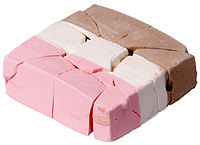
Photo from wikipedia
Abstract This study investigates the formation of subvisible particles formed by external stresses produced such as flicking and dropping syringes. Flow imaging was used to visualize and quantify microparticles from… Click to show full abstract
Abstract This study investigates the formation of subvisible particles formed by external stresses produced such as flicking and dropping syringes. Flow imaging was used to visualize and quantify microparticles from 1 μm to over 25 μm as a result of mishandling. Microparticles increased in the presence of silicone oil that was present in syringes. Thus, silicone oil in syringes may affect the activity of therapeutic proteins being injected. Present data showed detailed and differentiated morphologies of proteinaceous particles, silicone oil, air bubbles, and plastic debris in mishandled syringes. In some cases, the presence of bisphenol A in syringes was detected by FT-IR. Disposable plastic syringes were evaluated and showed differences in their content of silicone oil. Syringes that contain 0.45 μm filters inside the needle cap as well as silicone oil-free syringes release proteinaceous subvisible particles after mechanical stress. These stress-generated particles can be delivered to patients, compromising patient care.
Journal Title: International Journal of Pharmaceutics
Year Published: 2020
Link to full text (if available)
Share on Social Media: Sign Up to like & get
recommendations!